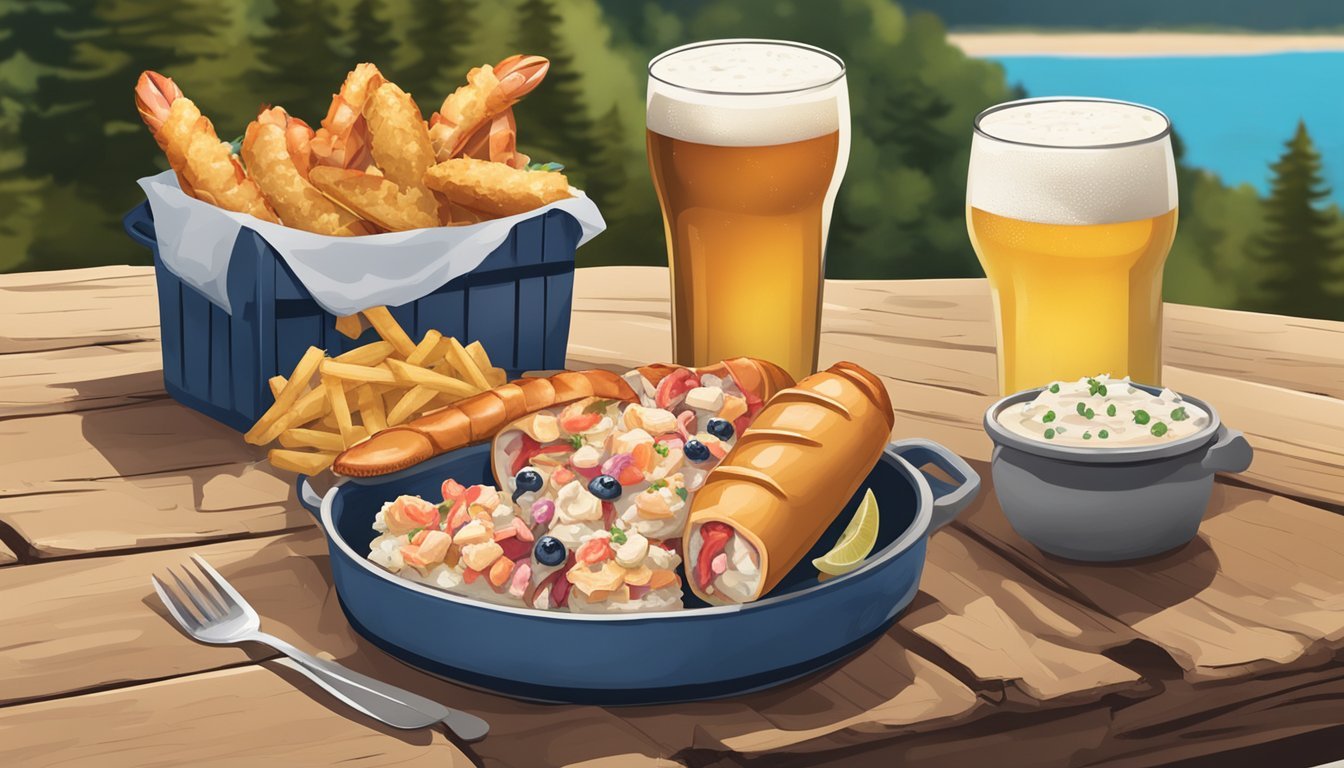What Food is Maine Known for?
Unveiling Iconic State Delicacies
Maine, the northeasternmost state in the US, is renowned for its distinctive culinary landscape, closely tied to both its expansive coastline and rich inland ecosystems. Known for its long-standing traditions in seafood (What wine goes well with seafood?), particularly lobster (What wine goes well with lobster?), Maine offers an array of gastronomic delights that reflect the state's maritime heritage and New England charm. These iconic dishes, sourced from the cold, bountiful waters of the Atlantic, include lobster rolls, crab (What wine goes well with crab?) cakes, clams (What wine goes well with clams?), and other seafood staples that have become synonymous with Maine's food identity.
In addition to seafood, Maine is celebrated for its wild blueberries, which are a staple in local desserts and found in abundance throughout the state's fields. Blueberry pie, crafted from these tart and sweet berries, stands as a symbol of Maine's agricultural abundance. Further embracing the state's natural offerings, seasonal ingredients like fiddleheads and maple syrup (how long does maple syrup last?) also contribute to the unique food profile of Maine, showcasing the state's commitment to utilizing local, fresh produce.
Maine's culinary scene does not end with its seafood and wild harvests; it also includes an array of native dishes and treats such as whoopie pies, an iconic state dessert, and the lesser-known Needham candies. With each bite, residents and visitors alike are invited to experience the full spectrum of flavors that embody the essence of Maine's local cuisine.
Significance of Seafood in Maine Cuisine
Maine's culinary identity is powerfully connected to its seaside location, offering a bounty of seafood that is vital to the state's culture and economy. From the iconic lobster to a variety of shellfish, the seafood experience is integral to understanding Maine's heritage.
Lobster: A Staple of Maine
Maine lobster is more than just a crustacean; it's a cultural symbol and economic powerhouse. The cold waters of the Atlantic provide the perfect environment for soft-shell lobster in the summer and hard-shell lobster year-round. Lobster rolls, a beloved regional specialty, are made with fresh lobster meat served on a roll, often with a touch of mayo or drawn butter. Steamed lobster is another traditional preparation, enjoyed for its tender texture and sweet flavor. The lobster industry is deeply rooted in the state, with numerous lobster boats dotting the coastline.
Diversity of Seafood Offerings
Beyond lobster, Maine's cold waters yield an impressive diversity of seafood. A few notable offerings include:
Clams and Oysters (What wine goes well with oysters?): With varieties like the coveted Maine oysters, known for their briny taste, and tender clams ideal for clam chowder.
Crab Cakes and Seafood Chowder: Locals create myriad dishes such as delectable crab cakes (What wine goes well with crab cakes?) and hearty seafood chowder incorporating fresh local catch.
Seafood Bakes: The New England clambake, a social event featuring steamed seafood, potatoes, and corn cooked over seaweed, is a treasured tradition.
Local Seafood Festivals
Maine's seafood festivals are a true celebration of the sea's bounty, reinforcing the community's bond to maritime life. The Maine Lobster Festival in Rockland is an annual event attracting thousands, famous for its vast servings of lobster. Other coastal towns like Boothbay Harbor and Bar Harbor also host events that feature local seafood, attracting locals and tourists alike to savor the state's specialties.
Sustainability of Maine’s Fisheries
Sustainable practices are key to maintaining Maine's seafood legacy. The state's fisheries adhere to strict regulations to ensure the health of fish populations and the environment. This approach assures that sustainable seafood continues to thrive, balancing industry needs with ecological responsibility. Furthermore, it helps maintain the supply of high-quality seafood to local and global markets, preserving Maine's reputation as a leading source of premium seafood.
Maine’s Agricultural Products
Maine excels in producing distinct agricultural products, with wild blueberries, potatoes, and maple syrup being the most notable. Each product has a deep-rooted history in the New England culinary landscape and forms a significant part of Maine's economy.
Blueberries: Maine’s Sweet Bounty
Maine is the national leader in wild blueberry production. These blueberries differentiate themselves from cultivated ones through their smaller size and more intense flavor. Maine's blueberry harvest contributes to a variety of popular dishes:
Maine Blueberry Pie: A quintessential dessert, reflecting Maine's rich blueberry legacy.
Blueberry Pancakes: A breakfast staple featuring the state's sweet fruit.
Wild blueberries not only thrive in Maine's acidic, glacial soils but also define the state's agricultural identity.
Potato Farming and Dishes
The potato is the cornerstone of Maine's farming, with the state's rich soil providing ideal growing conditions. Potatoes from Maine are turned into numerous dishes, including:
Mashed Potatoes: A versatile and beloved side dish across the United States.
Ployes: A French Acadian buckwheat pancake often graced with Maine's potatoes.
In addition to its food uses, the agricultural community surrounding potato farming is a significant contributor to Maine's economy and a connective cultural thread to its Canadian neighbors.
Maple Syrup Production
Maine proudly stands as a top producer of maple syrup in the United States. Producing Maine Maple Syrup involves traditional and modern practices that have evolved from the knowledge of the local forests and climate patterns. During the springtime sap flow, Maine's maple syrup industry comes to life, leading to:
Pure Maple Syrup: A natural sweetener for a plethora of dishes, showcasing the essence of New England's forests.
Maple Products: From candies to glazes, Maine's maple syrup is a versatile ingredient cherished beyond its borders.
Maine's syrup-making tradition is deep-rooted, contributing to the state’s reputation as a producer of some of the finest maple syrups in the region.
Iconic Dishes and Regional Delicacies
Maine is renowned for its unique and flavorful regional cuisine. This section explores the state's popular dishes, distinctive desserts and baked goods, and the rich, comforting chowders and soups that have put Maine on the culinary map.
Popular Maine Dishes
Maine's culinary landscape boasts a variety of iconic dishes beloved by both locals and visitors. Two standout items include:
Red Snapper Hot Dogs: These bright red hot dogs, known for their distinctive "snap," are a staple at cookouts and a must-try Maine specialty.
Fried Clams: Fresh clams, battered and fried to perfection, offer a crispy taste of Maine's local seafood.
Local Desserts and Baked Goods
Sweet treats and baked goods are an essential part of Maine's gastronomic identity, with several alluring options:
Whoopie Pies: Considered Maine's official state treat, these delectable cream-filled cake sandwiches are a local favorite.
Blueberry Pie: Utilizing wild Maine blueberries, this pie is a celebrated dessert, particularly during the berry's peak season.
Needhams: A unique candy made with coconut and mashed potato, covered in chocolate.
The Holy Donut: Known for using local ingredients like Maine potatoes in their famous donuts (how long do donuts last?).
Taste of the Sea: Chowders and Soups
Maine's proximity to the ocean is reflected in its comforting and hearty chowders and soups:
Clam Chowder: Rich and creamy, this chowder is filled with tender clams and often served with a sprinkle of fresh herbs.
Seafood Chowder: A broader take on the classic, incorporating various fresh seafood such as lobster, haddock, and scallops (What wine goes well with scallops?).
Each dish and treat mentioned holds a special place in Maine's rich culinary tapestry, illustrating the state's commitment to tradition and quality.
Unique Beverages and Accompaniments
Maine is not only celebrated for its esteemed seafood but also for its array of unique beverages and accompaniments that complement its rich culinary tradition.
Maine’s Legendary Drink Offerings
Maine's beverage scene is marked by its craftsman touch, most notably seen in the state's craft beer industry. Breweries dot the landscape, offering a wide range of ales and lagers that capture the essence of the state. Another iconic drink is Moxie, a distinctively bitter soda that Mainers have cherished since its creation. It is an acquired taste for some but undeniably a classic symbol of Maine's beverage culture.
Condiments and Add-ons
Flavors in Maine are elevated by artisanal condiments such as Maine Mustard and Maine Maple Syrup, which add a local twist to many dishes. Maine butter, often made from the milk of local cows, renders a richness to lobster rolls that is authentically New England. These accompaniments embody the state's knack for companions to their meals that are as memorable as the main course.
Regional Specialties
Among the edible treasures in Maine's forests are fiddleheads, the coiled fronds of the ostrich (What wine goes well with ostrich?) fern, and wild leeks, also known as ramps. These foraged delicacies offer a burst of local flavor to the springtime table and are featured both in home kitchens and restaurant dishes. Their unique flavors profile the changing seasons of Maine and hold a special place in the culinary experience of the region.
Local Food Culture and Experiences
Maine's culinary landscape offers an immersive experience into its food culture, highlighted by fresh local ingredients and traditional seaside fares that have become renowned nationwide.
Eating Out in Maine
Dining out in Maine is a treat for seafood lovers, with ocean-fresh offerings taking center stage. Lobster rolls are the state's pride, presenting tender lobster meat seasoned lightly and served in a toasted bun, often found in seaside shacks and upscale eateries alike. Towns like Portland and Camden provide diverse dining experiences where one can sample everything from intimate café foods to gourmet dishes. Maine's restaurants pride themselves on using local ingredients, with menus changing seasonally to reflect the freshest produce available.
Sample Local Specialties:
Lobster Roll
Clam Chowder
Blueberry Pie
Maine’s Food Festivals and Events
Maine celebrates its rich food heritage with numerous festivals and events year-round, uniting locals and visitors in their shared love for food. The Maine Lobster Festival, held in Rockland, is one of the most anticipated events, offering an abundance of lobster-based dishes. Food festivals across the state not only showcase seafood but also highlight other local products such as maple syrup, potatoes, and wild blueberries. These events offer an authentic taste of Maine culture and a chance to engage with the local community and traditions.
Notable Food Festivals:
Maine Lobster Festival
Machias Blueberry Festival
Maine Maple Sunday Events
Global Influence and Culinary Innovation
Maine's food scene is enriched by the embrace of international cuisines and the rise of innovative brands, showcasing a dynamic fusion of global flavors and local creativity.
International Cuisines in Maine
Maine's culinary landscape extends far beyond its borders, inviting a mix of global tastes into its kitchens. Portland, often seen as the food hub of Maine, boasts a diverse array of eateries that serve up authentic international flavors, ranging from Vietnamese pho to Italian pasta. These restaurants are more than just food destinations; they represent cultural exchange, providing Mainers and visitors alike with the opportunity to explore the world through their palates.
Vietnamese: Pho Co. serves traditional pho alongside other Vietnamese favorites.
Italian: Gianni's Italian Bistro is known for its homemade pasta and wood-fired pizzas.
Indian: Mumbai Spice offers a blend of traditional and contemporary Indian dishes.
Innovative Maine-Based Brands
Maine is home to forward-thinking food brands that are redefining the state's culinary identity. Stonewall Kitchen, for instance, started as a local farmers market stand and grew into a nationally recognized gourmet brand, selling specialty foods like wild Maine blueberry jam and other innovative products. These brands often incorporate Maine's rich, local food resources while pushing the boundaries of traditional flavors, sparking both state pride and broad appeal.
Stonewall Kitchen: Gourmet jams, mustards, and pancake mixes (how long does pancake mix last?) with a Maine twist.
Sea Salt Company: Harvesting salt from Maine's pristine waters to create unique seasoning blends.
In summary, Maine's culinary innovation and global connections are pivotal in shaping its food scene to be as vibrant and multifaceted as it is today.
Conservation and the Future of Maine’s Cuisine
Maine’s approach to food sustainability is characterized by its commitment to local sourcing and stringent environmental conservation efforts. This ethos is particularly evident in the state's celebrated seafood, which is fished with consideration for ecosystem dynamics and the long-term health of marine species.
Sustainable Seafood: The state is a proponent of responsible fishing practices, aimed at preserving the natural abundance of species like lobsters, clams, and cod. They meticulously regulate fishing seasons, catch limits, and gear types to minimize the ecological impact.
Maine Cuisine: Historically rooted in utilizing local resources, Maine’s cuisine continues to evolve with a focus on reducing food miles. Traditional dishes, which often feature seafood, are increasingly prepared with ingredients sourced from local farms and fisheries.
Local Food: There's a rising trend in Maine to increase the consumption of locally sourced foods. Initiatives like community-supported agriculture (CSA) programs and farmers markets are thriving, reinforcing the connection between Maine residents and their food sources.
Seafood: Seafood remains the cornerstone of Maine’s culinary identity. Ongoing conservation efforts ensure that seafood dishes (What wine goes well with seafood dishes?) will continue to grace tables, not only for their flavor but also as symbols of the state’s sustainability achievements. Local chefs are notable advocates for using seasonal and local ingredients, which informs both the future of Maine’s cuisine and its preservation.
These efforts, rooted in Maine's rich heritage and innovative spirit, are shaping a future where the state’s food system is as sustainable as it is flavorful. Through this conscientious stewardship, Maine's cuisine is set to remain both a local and a global exemplar of environmental respect and culinary excellence.
Conclusion
Maine's culinary landscape is a vivid tapestry woven from the sea's bounties and the land's harvest. Lobster reigns supreme as both a cultural symbol and a culinary delight, often served as delectable lobster rolls that tempt both locals and visitors. Beyond the celebrated crustacean, the state boasts a diverse seafood repertoire, including clams, known for starring in rich, hearty chowders, and a variety of other fish that are integral to Maine cuisine.
Blueberries, another state pride, grow abundantly and make their way into countless dishes, most notably pies. The state's commitment to using fresh, local ingredients is evident in every meal, solidifying Maine foods as representations of simplicity and quality.
Notable Maine Foods:
Seafood: Lobster, clams, and fish
Berries: Wild blueberries in desserts
Local Specialties:
Bean Hole Beans
Whoopie Pies
Red Snapper Hot Dogs
The cuisine of Maine reflects the state's deep connection with its natural resources, resulting in a unique and memorable food experience. Whether it's a simple snack or a lavish feast, the flavors of Maine's food are grounded in both tradition and a profound respect for what the environment provides. The state's culinary customs and practices continue to attract and satisfy those seeking a taste of the Northeast's authentic charm.








